The Post/Colonial Museum: Rethinking the Past, Collecting the Present
DCNtR Debate #3. The Post/Colonial Museum
A conversation with Dr. Silvie Memel-Kassi, former Director of the Musée des Civilisations, Abidjan, and currently Directrice Générale de la Culture de Côte d’Ivoire, Nanette J. Snoep, Rautenstrauch-Joest Museum, Cologne and Martin Zillinger[1]
Nanette J. Snoep (N.J.S.) & Martin Zillinger (M.Z.): In your work you’ve always stressed that the museum is a space of memory for communities and individuals alike. Museum objects are meaningful objects, they affect, as you once put it, the soul of the community and relate to questions of identity. Perhaps we should start our conversation by thinking about the mnemonic function of the museum.
Silvie Memel-Kassi (S.M.K.): The museum is indeed a place of memory. I think it is quite clear, considering the definition given to us by the International Council of Museums (ICOM). The museum is this truly permanent institution, a non-profit institution, in the service of society and open to the public. It acquires, preserves, studies, displays and transmits material and immaterial world heritage to provide for study, education and delectation.
Beyond this definition, we must also understand that the museum is the site par excellence where one goes to discover and learn about history, traditions, civilization, and the ways of life of peoples in their evolution. The Musée des Civilisations, which I direct, is an ethnographic and archaeological as much as an iconographic museum. It contains 15,000 pieces, from every region of Côte d’Ivoire. They form a testimony to the four cultural areas of the country and deal precisely with the material and immaterial culture of Côte d’Ivoire. The history of the peoples that preceded us is gathered together under one roof.
It is important to see how the people that come to the museum can not only discover themselves as specific and distinct entities, enriched at the sight of their diversity, they can also find inspiration for themselves as artists in the creation of traditional artwork. The museum is at once a catalyst both for creative potential and for a change in mentality for groups that are unaccustomed to visiting this space. Running an institution that has suffered violence and numerous crises over the last 20 years, we are quite aware of the magnitude of our project. This is why the permanent exhibition that we have at the moment was devised to engage with the topics of pride, symbolism and identity. Pride, because the different traditional, artistic creations exhibited essentially constitute the pride of the people of Côte d’Ivoire. Symbolism, because the artefacts – given their intrinsic value on an historical, archaeological and anthropological level are themselves symbols. They symbolise the cultural foundations of Côte d’Ivoire. Identity, for its part, speaks to the identity of Côte d’Ivoire.
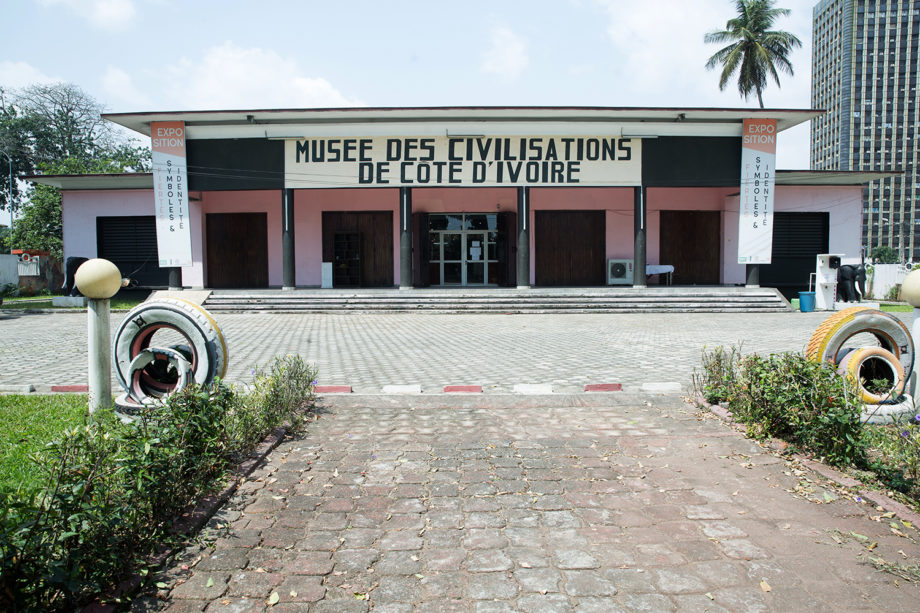
Fig. 1: Main Entrance of the Exhibition Hall. 2021. Photo: Museum of Civilizations, Abidjan.
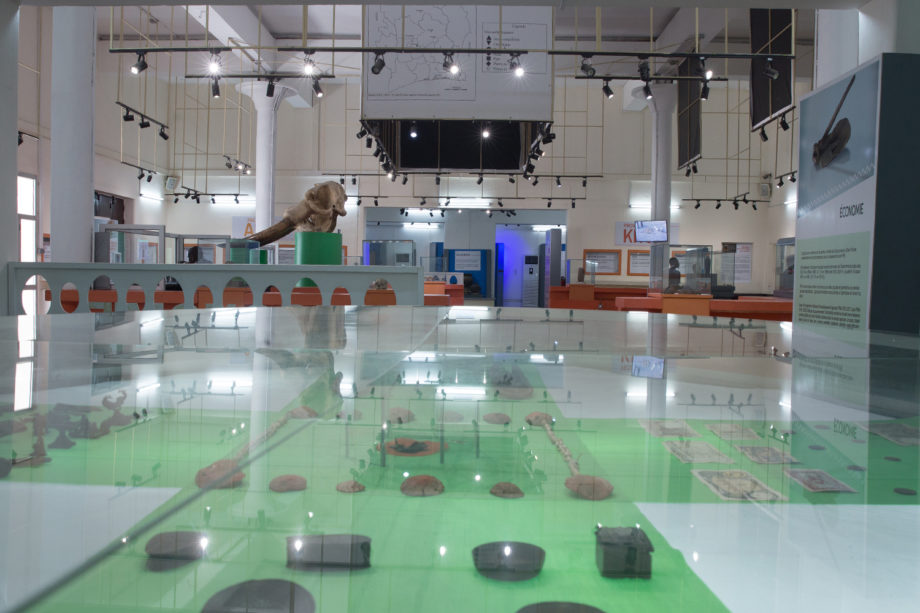
Fig. 2: Objects in Showcases, Permanent Exhibition. 2021. Photo: Museum of Civilizations, Abidjan.
We put this exhibition together in collaboration with all of the actors concerned and with the universities in Côte d’Ivoire. We included anthropological, technical and archaeological expertise in the making of the exhibition, in order to create a space in which people realise that their way of life depends on the choices that they make. For that reason, we also decided to include the Ivorian constitution in the exhibition. As you know, constitutions are a controversial subject in Africa. We displayed the text of the 2016 constitution so that Ivorians can genuinely understand its essence and its importance, but also to have the museum play a stabilising role in Ivorian society. We also wanted to put an emphasis on royality in Côte d’Ivoire in this exhibit, that is to say, on traditional political management in our communities. For that reason, I would say yes, we do discover our identity in all of these material and immaterial expressions.
N.J.S & M.Z.: Perhaps it is fair to say then, that the museum is not only a space of memory, of archiving and memorizing a past, but a mnemonic space, which lends itself both to remembering a past and to remind us of our positionality in the present. It seems that the importance of Macron’s speech in Ouagadougou speaks to the importance of the past as well as the powerful discourse in postcolonial societies that demands a re-definition of the present.
S.M.K: The museum has often been a theatre of anti-humanist acts, when we consider the theft and pillage involved. As far as President Macron’s speech goes, we could call it an historical speech because the issue of returning objects is of central importance for former colonies. The speech at the University of Ouagadougou was grounds for general euphoria; it was a central concern for African people. Everybody was waiting for that moment, which is why – once the euphoria had passed – African states started organising themselves. They did so individually and collectively, that is, at both national and regional levels, with the Economic Community of West African States (ECOWAS), which is composed of 15 member states, including Ivory Coast. First, there was a summit in December 2018 attended by certain members of governments and the heads of state who had decided to speak together with one sole voice and to combine forces against the complexity of the issue of restitution. This was followed in July 2019 by a meeting in Cotonou, Benin, organised by the ECOWAS Commission, which brought together the ECOWAS Ministers of Culture, who reflected on a plan for the return of cultural goods. The meeting resulted in the elaboration of two tools. Firstly, a regional cultural policy, i.e. a sort of white paper in which major axes regarding the return of objects – as the points on which all member states should speak as one – were defined. Secondly, the 2020–2022 action plan. The action plan is a kind of road map that was given to each country so that, on both a local and national level, concrete action could be taken with a view to preparing for the return of cultural goods.
Any conversation about Côte d’Ivoire should clearly state that the issue of restitution neither emerged nor took shape with President Macron’s speech. The issue of return has always preoccupied African states. As early as 1987, Amadou-Mahtar M’Bow provoked public outcry when he spoke of African states’ need to recover symbolic objects being kept in the West. The same issue was addressed in correspondence between Ivorian president Félix Houphouët-Boigny and his Senegalese counterpart Président Senghor in 1977. Indeed, the despoliation of cultural goods is an ethical and moral issue because people have the right to enjoy their heritage as they see fit. For me, restitution is, as such, a work of justice and humanity. We need our objects because of the purpose they served and which is crucial for the balance and stability of our societies.
N.J.S. & M.Z.: You are the director of a museum which was founded by French colonial officers. The collection was part of the colonial project to administer Côte d’Ivoire, similar to other places on the continent perhaps, whether it was German, English or French policies that framed the endeavour of collecting, documenting and classifying humans, artefacts and objects of nature. But despite the rhetoric of salvaging culture for educational purposes and for the people of Côte d’Ivoire, thousands of objects were brought to France during and after colonial rule. How does this problematic and violent history impact your work in the museum?
S.M.K.: To give you a concrete example, there is a sacred drum belonging to the Ebrié community, that is to say, to the people in the department of Abidjan, which is the economic capital of Côte d’Ivoire, where we currently find ourselves. The sacred drum is considered a cultural asset by the Ebrié. The talking drum was stolen by the colonist in 1920 while he was looking for workers to build the railway lines in the colony. What happened is that every time the white man came to the area, it seemed no one could be found, it was deserted; because of the drum. The instrument was used as a means to communicate, to sound the alarm that the colonist was about to arrive. It wasn’t until some time later he realised that this drum, measuring three and a half meters in length, was the informer. So it was that the drum was torn from the community in 1920. Some years later, in 1930, it was found in the collections of the Musée de l’Homme. Today, it’s part of the collections of the Musée du Quai Branly.

Fig. 3: Djidji Ayôkwè Ébrié Drum in the possession of the Musée du Quai Branly. 2021. Photo: Musée du Quai Branly, Paris.
Museum management was exclusively carried out by European conservators during the colonial period and even during the first years of African independence. The men were adept at creating networks through which the museum collections from colonised countries would flow. In that business of dispossession, it is not difficult to remember the quite significant role played by French ethnologist, and former director (1947–1978) of the Abidjan Museum, Bohumil Holas who helped transfer collections from the Musée National d‘Abidjan (which was the former name of the Musée des Civilisations de Côte d’Ivoire). During one of our visits to the Musée du Quai Branly in June 2007, we were shocked to see an impressive donation of a thousand objects from Côte d’Ivoire to France, for which Holas was responsible.
N.J.S. & M.Z.: What do you think restitution would look like?
S.M.K.: The restitution of cultural goods is a complex issue. What form of advocacy should be used? What strategy should be put in place in terms of an official demand for the reinforcement of the legal framework? What approach should be adopted to successfully meet the challenge of restitution? Up until a few months ago, one could speak of two blocks in Africa regarding this question. There was a block in favour of immediate and unconditional restitution and another advocating a consensual approach based on diplomacy. Today the states at the heart of the ECOWAS have come to understand that the process adopted by the French government, where each country’s request is examined case by case, could well take some time, hence the need to consider a strategy through which member states do not emerge as losers. I agree with Bénédicte Savoy’s emphasis on the need for cooperation between all parties involved in the process of restitution. This is not an issue for state agencies alone. In point of fact, restitution demands cooperation between experts and others, such as conservators at museums, people working on heritage, academics, legal experts, representatives of traditional communities, artists, and so on. The other main difficulty is undoubtedly that of the precise number of cultural goods currently stored overseas, which is difficult to ascertain given that African museums did not keep inventories of their collections during colonial times. This, in turn, has grounded the need for bilateral or multilateral cooperation to encourage the creation of formal chains of exchange.
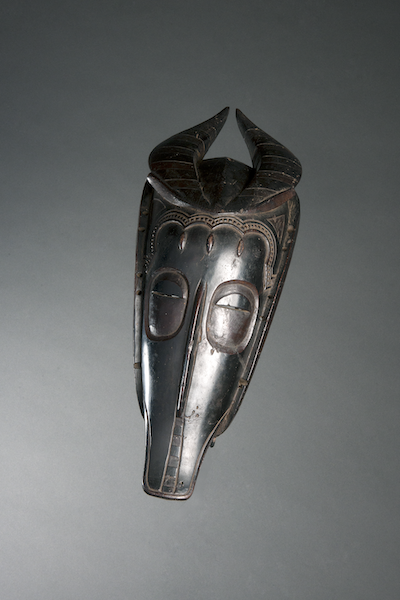
Fig. 4: Masque Zamblé (Gouro). No. Inv. 50.2.918. 2021. Photo: Museum of Civilizations, Abidjan.
For our part, we enjoy positive relations with the Musée du Quai Branly whom we know well and with whom we have shared experience. We should not forget, however, that it is thanks to the tremendous work of Bénédicte Savoy and Felwine Sarr that we are aware of the 3,951 pieces from Côte d’Ivoire at the Musée du Quai Branly
N.J.S. & M.Z.: How do you evaluate these objects, how do you classify what it is that you want to recuperate?
S.M.K.: President Macron was right to suggest that we first give priority to symbolic objects. These are landmark objects that have gone with worlds, that have gone with wisdom, that have gone with lives, and so you understand that having gone, these objects have created a void in their communities of origin, in their original setting, and this has structurally disrupted the life of these communities. Take the Krou Wê people as an example. Unlike other peoples of Côte d’Ivoire – such as the Akan, Gour, or Mande, who organise around court cultures and the institution of the king at its centre – the Krou Wê have no central power. Authority in the village is linked to the mask, which is handed down from father to son. In times of crises, it is the mask that intervenes to regulate the life of the community, it therefore functions as a guardian, a protective mask. Hence, to the extent that these objects have been removed, you understand that the power of the customary chiefs and the overall established order has also taken a blow. The mask was feared because it had power, when the mask appeared, everyone was reminded of the need for coherence, to re-adjust. If there was a wrongdoer who didn’t respect the established rules, the mask had the power to send a disease, even death. As long as the mask was there, order was respected, and once it was removed there was an imbalance. So if we talk about choosing objects for restitution, we need to talk about these landmark objects, these symbolic objects. Also, for the Musée des Civilisations, there is concern around the fact that we do not currently represent all the cultures of Côte d’Ivoire. We call it the Musée des Civilisations and yet there are entire regions that remain unrepresented in the museum’s collections. It should be clear – precisely because the Musée des Civilisations is a vestige of the colonial administration – that the regions, which came into contact with colonial administrators early on, are precisely those whose cultural goods were taken. Our main concern is for the lagoon regions and the south of Côte d’Ivoire, which do not have enough traditional objects in the national collections. In my opinion, works from these regions ought to reappear.
N.J.S. & M.Z.: Thank you Silvie! Let us please talk about the wonderful project that you have put in place called La Collection fantôme. What is a Collection fantôme? And how do you make it tangible through an exhibition?
S.M.K.: La Collection fantôme, that was our way of reacting to the looting of the Musée des Civilisations. The creation of this multifaceted cultural project allowed us to de-dramatise the acts of violence committed against the country’s national collections. La Collection fantôme is, as such, a collection of artistic responses to the issues raised by the phenomenon of illegal trafficking of cultural goods, of which the Musée des Civilisations was a victim in 2010. La Collection fantôme, and the manifesto accompanying it, aim not only to address and prepare mentalities as regards the return of original goods that had been kept overseas, it also seeks to establish an impulse among the communities for the pres- ervation of cultural goods. French and Ivorian schools alike have seen the implications of the pedagogical content. So what really happened? Our museum is located besides the Ministry of Defence and was hit by a shell that shook all of the buildings. We only just had the time to close the doors and run. 121 pieces were stolen, including the gold collection of the first president Félix Houphouët Boigny. The gold of the Akan people is sacred. It also a precious good for distinguishing certain individuals (generally royal families) and corresponds to social, political and economic power. Hence, when the looting occurred, it was really quite disastrous. With the disappearance of the objects, a part of the culture was erased. We spoke a lot about the subject in the media. Unfortunately, the investigation hasn’t gone anywhere.
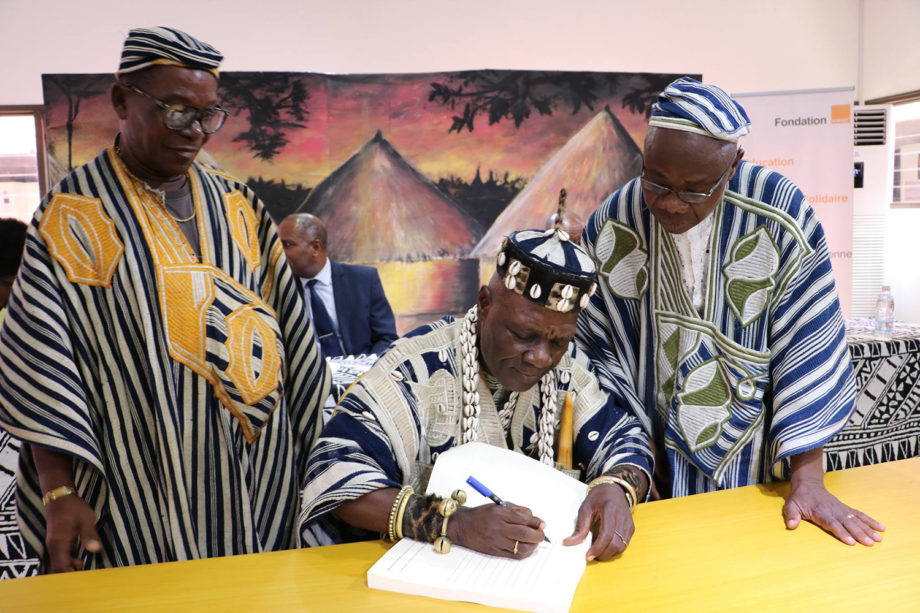
Fig. 5: Signing of the manifes- to La Collection fantôme by His Majesty Toubo Taho Maurice, Supreme Chief of the Wê, surrounded by his notables. 2018. Photo: Museum of Civilizations, Abidjan.
La Collection fantôme, or the collection of disappeared objects, is both a cry from the heart and a lament, because neither the country nor the communities that produced the objects will be able to forget. This project exists to remind us that the objects will always remain in memory, even if they have disappeared. It’s like losing a limb. Even if you amputate an arm, you can still feel its absence when you move the remaining one. We thought that the best place for this project to germinate was in schools. This would give it an educational and pedagogical dimension. We turned our attention to schools so that the children of tomorrow could grow up with a museal awareness, defending their culture. In Africa, you often have the impression that no one is interested when you talk about culture. For my part, I am convinced that this is largely the result of the fate inflicted on Africa since the disastrous geographical division imposed on the African continent at the Berlin Conference
It is for this very reason that we need to raise our voices as much as possible, so that not one single person in Côte d’Ivoire can avoid hearing about the Collection fantôme. The project has brought together representatives of the cultural world, local partners, Interpol’s National Central Bureau, the UNESCO bureau in Abidjan, the Ivorian National UNESCO Commission, prefects, mayors, police, customs, regional directors of culture and customary authorities, in short, all those concerned with the issue of heritage preservation or the security of museum collections.
For the next step in seeking to fight illegal trafficking, it was important to make the campaign international. On Kader Attia’s invitation, we went to la Colonie in Paris, with the fantôme collection under one arm. Kader Attia later joined us in Abidjan, as well as the French artist Sébastien Rémy, who was in residence at the museum for two months to work on the Collection fantôme. All within the framework of this project, there were exchanges with the Ivory Art Centre, which led to a partnership with the Bingerville School of Applied Arts and the Art Department of the Félix Houphouët-Boigny University.
The theme of the work for the Paris group was Ceux qui nous regardent (those who watch us). It was about inverting the colonial gaze. Know that Africa is watching you! Let’s just talk about your so-called universal museums that are filled with our cultural goods. The question on the African’s lips is this one: These collections – preserved in public collections in the West – for whom are they important? For the countries of origin or for those who took them? The campaign for Côte d’Ivoire is Non à la culture du vide because the mobility of cultural goods on the continent is our responsibility too.
We hope that in time these efforts will culminate in a major exhibition on the Collection fantôme. When the project was launched in 2017 in Abidjan, we dressed mannequins in white cloth with holes in the eyes to look like ghosts. We set up empty showcases and convinced visual artists to provide contemporary creations, while other artists recited poetry. We would love to work with musicians for this project too. We need to get people to come together so that the issues of return and the preservation of heritage are shared by everyone, and so that looting and trafficking can no longer occur as they do today
N.J.S. & M.Z.: In Germany, the institution of the anthropological museum, with its enormous collections, has come under siege. As we know, only a fraction of the collections are ever exhibited, not to speak of the research. More and more people talk about de-collecting, opening up the archives, releasing objects from the depots. The repatriation of objects is only one element in your reflections on linking the Museum of Civilisations, comprehensively, with the different communities. You also mentioned issues of representation, which are important for how you manage the collections and exhibitions in the context of Côte d’Ivoire. Does the question of collections also extend to the present, is there a collection of the present – or, in short, what might a postcolonial collection look like
S.M.K.: It’s an important issue. How do we create a post-colonial collection now that we’re the ones running things, rather than those Western anthropologists from the pre-independence period? Well, when I arrived at the museum, I had my own idea of museum management I have to say, and it’s not necessarily one shared by other Africans. Once I’d made my way to the top of the museum in 2006, I realised that an awful lot was missing. The state budget for the museum, which is a public museum, was really quite insufficient for its status. What’s more, there was no protocol for the acquisition of objects. Apart from that, it was clear to see in the inventory that certain regions were nowhere to be seen in the museum’s collection. We decided to identify those regions and start classifying their cultural and artistic wealth. We turned to academic researchers and started working a lot with archaeology and history departments in the universities here. We drew up a list of objects that ought to be integrated into the museum.
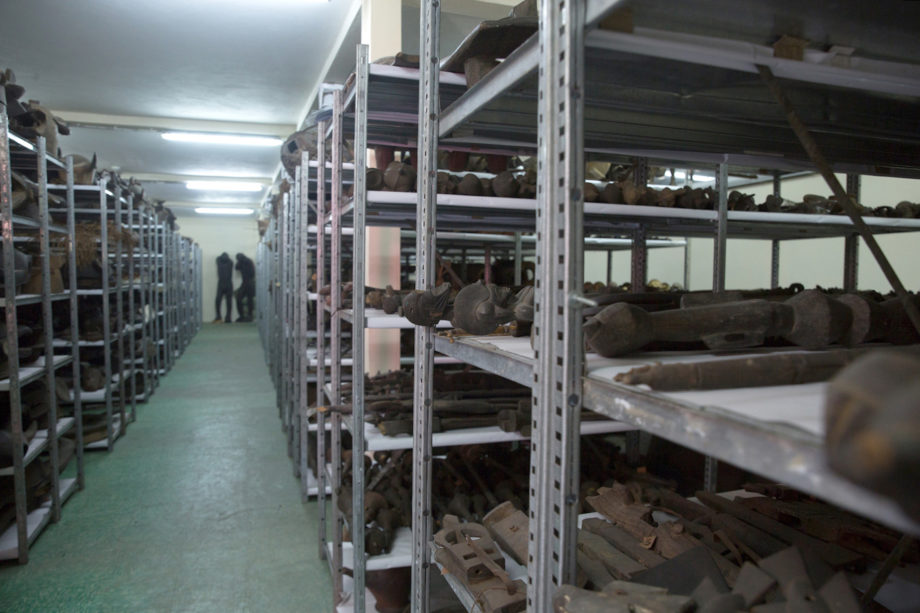
Fig. 6: View into the Depot. 2021. Photo: Museum of Civilizations, Abidjan.
How was the collection carried out? When we identify a region, we send a letter to the customary administrative authorities and do what’s called a pre-collection, a pre-project, we go out and meet with the community we’re interested in. You know, of course, that speaking with a community means speaking with the chief, with the nobility. You cannot simply go see some individual or other and say: »this is what I’m interested in«. Well, we typically go there and meet with the relevant authorities and explain the situation to them. We talk to them about the merit of the project, that the museum is this place where they and their children will be able to come and see the objects that are in the museum. We emphasis the risk of losing these objects, due to illegal trafficking or corruption, if the objects remain there with them. The fact is that wherever people are poor in Africa, there’s an elevated risk of illegal trafficking.
Let me tell you about something that happened to me not so long ago and that is significant in this respect. In 2015, we received a visit from Mr Kouamé who came from the Toumodi region in the centre of the Côte d’Ivoire. He came to tell us about two men who’d come to his village during the night. They had arrived at two in the morning, went straight to the oldest man in the village and said: »We want you to give us the sacred mask that is in your house«. This sacred mask emerges every seven years for atonement ceremonies or whenever the eldest person in the villages passes away. When the old man refused, they took out their phones to talk to someone who knew the house and who told them the location of the sacred mask, which was kept in a suitcase under the bed. Once they’d committed their crime, they left. To this day, the mask has never been found. For us, it was a clear sign that we cannot work alone. We must work collectively if we’re to curb the scourge of theft.
As such, working with communities means alerting them to the risks of losing their objects, letting them know they do have a choice. The objects we offer to safeguard are authentic objects, if it’s a mask, it must be a mask that has actually danced. But we certainly don’t ask for the central mask, we don’t say »give us the mask that is the subject of all the libations, all the incantations«. Instead, we suggest another that goes along with it. To be sure that one has also its importance and may be crucial for the community. But the practice of simply demanding the most valued object was at the centre of museum work in colonial times, and continued well after the colonial period.
In terms of the history of the museum, I can remember the institution that houses the Musée des Civilisations being a festival hall originally. During the World War, the governor at the time made the space available to Ivorian artisans so they would come and display the best samples of their artistic works. After the war, the disused festival hall was turned into a museum and those best samples were kept there, as well as authentic objects collected in the communities. We explain all this to the communities who then generally respond: »We understand, yes, we’ve taken careful note, and it’s our wish that the names of our communities be perpetuated through our cultural goods, for posterity«.
I think it’s important that we don’t impose our will, and we let the communities decide for themselves. Generally speaking, this policy works exceptionally well, given that after some time and reflection, the communities themselves give you the best of their artistic works. They’ll tell you, for example, that such and such an object is very important because it belonged to the greatest of the warrior chiefs or to the founder of the community. After that, once weve agreed on which works are to be taken, we go on to the next phase. We go back out with the technical team, equipped with all the necessary equipment and in certain cases with payment for the purchases.
This cooperation in collecting is equally important as an epistemic practice, so to speak. Certain ancient works in Western collections contain erroneous information. The fact is that in certain traditional societies during colonisation, the white man was considered a stranger. He did not have access to accurate information. They would respond to his questions with fake answers that would have the whole community giggling as soon as he’d turned his back. It’s clear to see from the names that were given to certain villages or towns of African peoples. Essentially, when a stranger comes, we don’t give him all the information, we just tell him what he wants to hear. I realised that while I was visiting two great museums in ›the West‹. A significant part of the information displayed on the labels or in the explanations was inaccurate.
That is also why we prefer the communities to tell us »here, we want you to take this«. Often it is also the first generation objects that they give us. They tell us »no, there is no problem, we will take this, take the major object, if you have it, we can rest assured«. And the advantage of this kind of collaboration is that these communities are involved in everything we do here at the museum. When we have openings or other kinds of activities we involve the customary authorities. They also frequently come to our houses. Descendants of the communities come to see the objects from their homes that are stored in our collections. For what may be called ›scientific documentation‹ we work together with history departments and archaeology departments, which send us their doctoral students, for example, who help us in doing the documentation work
N.J.S. & M.Z.: Do you see this as a new form of cooperation with the communities in the country? It seems to be redefining the task or the mission of the museum, don’t you think? It is about building a museum that is there for the communities
S.M.K: Well yes, but there is still a long way to go. Material and financial resources are really crucial here. You may have the most wonderful ideas, but if you can’t get them off the ground there’s no use at all.
When I arrived at the museum, I wanted to think the museum differently. For me, the ideal museum would be one in which communities recognise themselves. It thus needs to differ very much from the classical museum in its colonialist conception, which we’ve gotten used to in Africa. Museums were institutions for receiving elitist populations, spaces dedicated to whites only. Excuse me when I say white, in Africa we understand very well that, traditionally, these spaces are dedicated to Westerners only. When I arrived in 2006, I drew up entrance statistics to see how many people attended the museum. The statistics showed that it was mostly Westerners, followed by Africans, and then the local public – and to me, that was not normal. The museum is established, first and foremost, for the people to whom it belongs. For me, running a museum without the local public is a failure, so what should be done? We’ve always been told that in Africa, Africans do not visit their museums, perhaps because Africans have not yet thought of a purely African museum. For me, an African museum should be one which people are proud to visit. The ideal museum is the museum that responds to the daily concerns of the communities, of the audiences that surround it, this is a museum in which the objects speak directly to those who visit. Wherever the objects are silent and there is no communication, however, I’d call that plain failure. Whatever it may be elsewhere, in the context of Côte d’Ivoire, the populations must recognize themselves in this museum. As such, the museum must be inclusive, even if it looks outward, it should be inclusive above all else. That’s very important for me. But to achieve this, it’s really a question of political, financial and cultural support.
N.J.S & M.Z.: This is an important issue for all museums. How were you able to build this kind of support?
S.M.K: Thanks to a concept that we created, and baptised LA NOUVELLE VISION, our activities have benefited from diverse support. It was a policy that took every aspect of the development of the museum into account. I think that the development of fundraising, as well as the placements that occurred at museums in the United States, were also decisive. It was in the U.S. where we learned how to put together funding projects. The last thing to mention is the Tapa Foundation, an NGO we created at the suggestion of some American friends in 2002. And they were right: in Africa, private donors don’t give much money to state institutions, they prefer to fund NGOs. I created the foundation to gather funds for African museums, and the Musée des Civilisations in particular. Companies would normally close their doors to me because I direct a national museum, but the same companies are quite accepting when I come in my capacity as president of the Tapa Foundation. We are thus funded from both the public and private sector. In terms of strategies, we began by choosing a museum ambassador who worked in an international financial institution. It was thanks to him that the museum was first renovated. We took over the lighting of the permanent collection in 2006 and went on to set up the permanent exhibition Identité et brassage des cultures. The ambassador put his address book at our disposal.
We looked for other partners, got the media involved, and drew up a partnership with the national press, so that every three months we were on the 8 o’clock news. Plus, all the museum’s activities were publicised, which meant that everybody started hearing about it. There was equally an historic partnership (which is still ongoing) with a mobile phone company (Fondation Orange Côte d’Ivoire). Either annually or every two years, according to the programme, the foundation we created to support museums gets funding from our partners at Orange. We were thus able to furnish every museum in Côte d’Ivoire with IT and technical equipment (dehumidifiers or thermohydrographs). The Tapa foundation also works with several embassies including those of France and the United States, who funded the digitization process. At an international level, the NGO has enjoyed, and continues to enjoy, the financial support of organisations that work on cultural heritage.
We launched the project La visite des élèves premiers de classe to reach a wider audience. With the support of local partners who provided transport, every primary school class in Abidjan came and visited the museum. I see the children that came as their parents’ ambassadors to the museum. They thus managed to have their parents come as well. There have been other projects such as the Le musée vient à vous which saw the museum head out to meet the public, to organise exhibitions outside the museum walls, in schools and in other public spaces. It is quite encouraging that there are schools from the coun- try’s interior that come to visit the museum now. We’ve gone from 8,000 admissions in 2006 to over 50,000 today in the main hall, and on the museum site itself over 120,000 visitors before COVID-19. The museum also receives more than 200 students of diverse nationalities on placement each year. Today, we receive requests for the museum space to be used for weddings and other social events. So, you see, the museum is becoming indispensable in the lives of groups and companies. In my opinion, this is what a museum should be ideally; a museum that is nourished and enriched by diverse contributions.
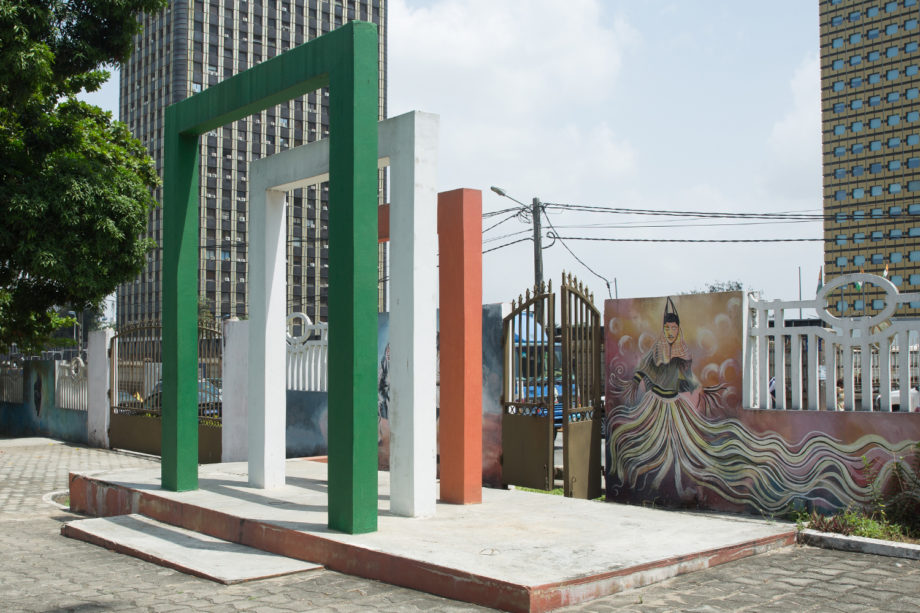
Fig. 7: Pedestrian Entrance to the Museum of Civilizations. 2021. Photo: Museum of Civilizations, Abidjan.
One last point on collaboration: we collaborate with the musée du Quai Branly at the moment, but I dream of opening our museum up to others as well. In the 38th UNESCO Recommendation concerning the Protection and Promotion of Museums and Collections, as well as their diversity and their role in society, provisions are made for cultural bridges and mutual assistance between museums in depository countries and those in countries of origin. As far as I’m concerned, objects that were deported no longer belong exclusively to one country. Today, those objects have double nationality, whether we like or not, and we should endeavour to establish collaboration. Museums in Africa are very young and we should cooperate to make them grow. After all, the objects we have, the collections we manage, the works we have, they’re all part of world heritage. If we want to pass on the history of the world tomorrow, and have better balance for the well-being of all our populations, we have an obligation to work hand in hand.
The conversation took place on February 19, 2021. After the transcript of this exchange was revised by the interlocutors, the subsequent translation into English underwent a thorough copy-editing. We thank Michael Dorrity for the latter, and Manon Raynaud for her meticulous transcription of the conversation.
The print version of this text is published in the Zeitschrift für Kulturwissenschaften, issue “The Post/Colonial Museum”, 2022, p 123-136. In order to make the issue “The Post/Colonial Museum” available to a wide readership, specifically on the African continent, we decided to use the long standing collaboration between boasblogs and the Zeitschrift für Kulturwissenschaften to successively publish all contributions in print and online (as DCNtR debate). We thank the editorial boards of both, the Zeitschrift für Kulturwissenschaften and the boasblogs, as much as the publishing house transcript for embarking on this project together. Furthermore, our thanks go to the participants of the conference on Museum Collections in Motion, which was generously supported by the Global South Studies Center, University of Cologne, the research platform “Worlds of Contradictions”, University of Bremen, the Museumsgesellschaft of the Rautenstrauch- Joest- Museum and the Foreign Office of the Federal Republic of Germany. Most of all, we thank the contributors to this debate for four years of exchange, debate and intellectual companionship.
Footnotes
[1]The print version of this text is published in the Zeitschrift für Kulturwissenschaften, issue “The Post/Colonial Museum”, 2022, p.123-136, https://www.transcript-verlag.de/978-3-8376-5397-7/the-post/colonial-museum/
Dr. Silvie Memel-Kassi, Directrice Générale de la Culture de Côte d’Ivoire: Biographie folgt.
Nanette J. Snoep, Director Rautenstrauch-Joest Museum Kulturen der Welt: Biographie folgt.
Prof. Dr. Martin Zillinger, Lehrstuhl für Sozial- und Kulturanthropologie, Universität zu Köln: Biographie folgt.































